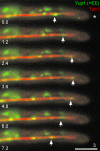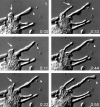Hyphal growth: a tale of motors, lipids, and the Spitzenkörper
- PMID: 17259546
- PMCID: PMC1828937
- DOI: 10.1128/EC.00381-06
Hyphal growth: a tale of motors, lipids, and the Spitzenkörper
Figures







References
-
- Agrios, G. N. 1997. Plant pathology. Academic Press, London, United Kingdom.
-
- Akashi, T., T. Kanbe, and K. Tanaka. 1994. The role of the cytoskeleton in the polarized growth of the germ tube in Candida albicans. Microbiology 140:271-280. - PubMed
-
- Archer, D. B., and D. A. Wood. 1995. Fungal exoenzymes, p. 135-162. In N. A. R. Gow and G. M. Gadd (ed.), The growing fungus. Chapman and Hall, London, United Kingdom.
Publication types
MeSH terms
Substances
LinkOut - more resources
Full Text Sources
Medical

